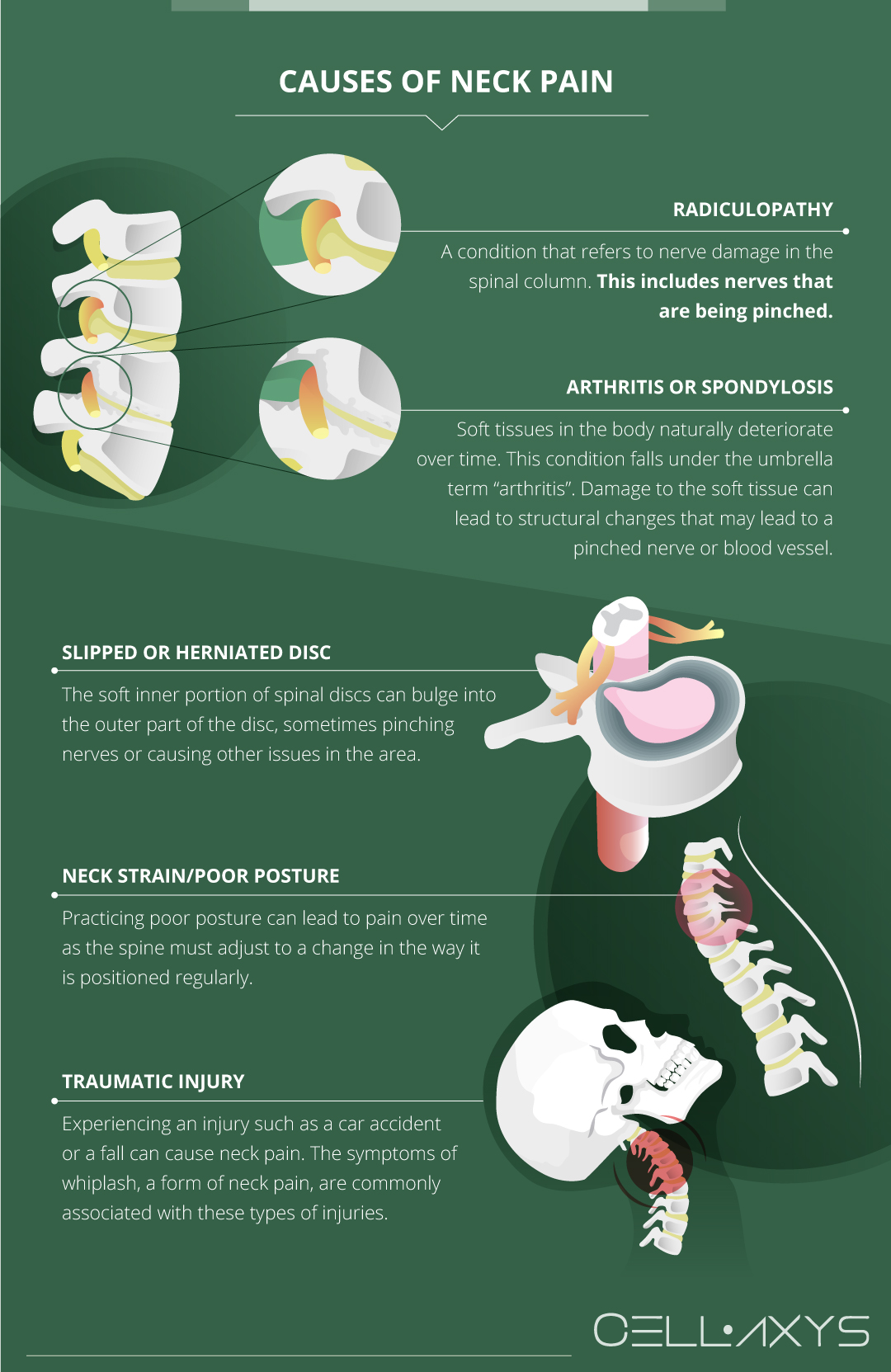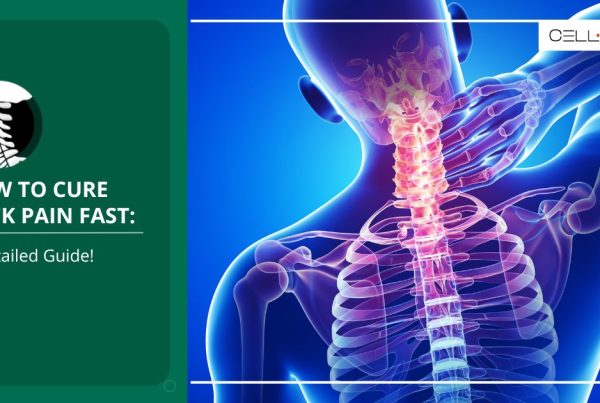Published on: November 6, 2019 | Updated on: August 29, 2024
The neck is one of the most common areas susceptible to chronic pain. Oftentimes, when pain is reported in the neck, it is misdiagnosed and mistreated.
Poor posture, injury, or natural degeneration of tissue are some examples of what could be causing pain in this area. Due to the sensitive nerves and blood vessels in the neck, pain often is accompanied by symptoms such as numbness, weakness, and tingling.
Some individuals also report feeling dizzy, nauseous, getting headaches, and vertigo while experiencing pain in the neck.
Anatomy of the Neck
The spine consists of three sections, called the cervical (neck region), the thoracic (upper back), and the lumbar (lower back) spine. There are 24 total vertebrae in the spine, and the cervical spine contains 7 of the vertebrae.
Between the vertebrae are spinal discs which serve as cushions between the bony vertebrae while also creating support and flexibility. The functions of vertebrae are to stabilize the spine and provide support for the spinal cord and nerves.
Nerves are fibers that transmit signals from the brain to the rest of the body and are a crucial part of all movement. Nerves can become pinched or damaged in the spine. This can be the underlying cause of many symptoms including numbness, tingling, pain, instability, dizziness, and more.
Causes of Neck Pain

Pain in the neck can have several potential causes. Some of the conditions associated with this type of pain include:
- Radiculopathy: a condition that refers to nerve damage in the spinal column. This includes nerves that are being pinched.
- Arthritis or spondylosis: soft tissues in the body naturally deteriorate over time. This condition falls under the umbrella term “arthritis”. Damage to the soft tissue can lead to structural changes that may lead to a pinched nerve or blood vessel.
- Slipped or herniated disc: the soft inner portion of spinal discs can bulge into the outer part of the disc, sometimes pinching nerves or causing other issues in the area.
- Neck strain/poor posture: practicing poor posture can lead to pain over time as the spine must adjust to a change in the way it is positioned regularly.
- Traumatic injury: experiencing an injury such as a car accident or a fall can cause neck pain. The symptoms of whiplash, a form of neck pain, are commonly associated with these types of injuries.
Due to the many nerves, muscles, cartilage, tendons, and bones in the neck and throughout the spine, there are many potential causes of pain – any one of these structures can become injured or damaged, causing pain.
When neck pain is resulting in other symptoms such as dizziness, headaches, or vertigo, it is often nerves or blood vessels to blame.
Nerves and blood vessels are constantly sending information and oxygen to the brain, so if either becomes pinched or damaged and cannot perform its normal function, it can lead to these symptoms.
Signs and Symptoms
Neck pain can surface in many ways. The pain can be short and sharp, a dull ache, or it can be anywhere in between. Some individuals experience chronic neck pain while others are in pain only when performing certain tasks or laying in a specific way.
It is recommended that an individual seeks the advice of a doctor when pain begins to impact daily activities. For some, this means not sleeping well, for others it could mean that it is too painful to sit at a desk or exercise. Some common symptoms of neck pain to look out for are:
- Dizziness
- Nausea
- Headaches
- Lack of balance
- Stiffness or soreness
- “Pins and Needles” feeling or numbness
These symptoms typically occur above the shoulders but can translate to other parts of the body such as the shoulders or arms depending on where the damage occurs.
Diagnosing Neck Pain
Due to the many potential causes of neck pain, doctors often employ the aid of technology to make a proper diagnosis. They may begin with a physical examination, including observing a patient’s range of motion in the neck and locating the source of pain. Being completely honest about symptoms is important so that doctors can make a well-informed diagnosis. Some of the technologies used to diagnose pain in the neck include:
- CT scan: this form of imaging can create a 3D image of parts of the body that may indicate an abnormality, including a pinched nerve or blood vessel.
- MRI: Magnetic Resonance Imaging is used to create an image of soft tissues in the body, which can be used to determine if there is damage occurring that may be causing pain and other symptoms.
- X-ray: this form of imaging is primarily used to detect abnormalities of the bone or joint.
- EMG: Electromyography is a test that involves inserting needles into nerves and testing the body’s reaction time once an electrical signal is sent through the nerve. A slow reaction time indicates damage to the nerve.
Some doctors may order other forms of testing, but these are the most common and practical. Though these tests are quite accurate, it is important to be open and honest with doctors about symptoms before the tests occur so that doctors don’t order unnecessary testing.
Conventional Treatment of Neck Pain and Related Symptoms
The treatment process will be different for every patient depending on what the underlying cause is. Generally, pain is initially treated by recommending that a patient rest the area as much as possible. The period of rest may be accompanied by pain medications. If this initial treatment is unable to ease the symptoms, other practices may be put to use:
- Physical therapy: the goal of physical therapy for neck pain focuses on posture correction, strengthening the muscles surrounding the spine, alleviating symptoms, and preventing future injury.
- Medication: some medications may be prescribed or recommended to manage pain. Depending on the symptoms, doctors may also prescribe medications that are meant to treat nausea and dizziness as well.
- Transcutaneous electrical nerve stimulation (TENS): this form of treatment sends electrical impulses through the nerves in an attempt to alleviate pain.
- Neck brace: wearing a device that provides support to the neck could help to take some pressure off of muscles in the neck, but should be closely monitored as it could cause more damage if used improperly or too often.
- Corticosteroid injections: doctors may opt to inject a synthetic form of cortisol (a naturally occurring anti-inflammatory property) to ease a patient’s neck pain. This kind of treatment is often successful in treating pain in the short term but has been reported to damage nerves and soft tissue over time if used excessively.
- Surgery: rarely, neck pain is treated using surgery. There are several types of surgery that may be used to treat this condition, and each has its list of risks and potential complications. It is important to maintain an open discussion with your medical team to be well-informed while deciding to undergo surgery.
The amount of potential treatment options changes depending on what is causing the symptoms. Once a proper diagnosis is made, doctors can begin to formulate a plan for treatment that is unique to each patient.
Alternative Therapies for Treating Neck Pain, Dizziness, and Headaches
A new field of medicine called regenerative medicine uses a patient’s own cells to heal injuries or damage done over time. These treatments may be a good option for someone experiencing neck pain and related symptoms. They are particularly effective for soft tissue injury.
When damaged or pinched nerves cause pain and headaches, regenerative treatments can offer a minimally invasive way to treat the root cause of the disorder. Treating the root cause, issues such as headaches, nausea, and dizziness will be addressed, along with neck pain.
CELLAXYS offers two types of treatments in the field:
Cell-Based Therapies
Also known as stem cell therapies, this form of therapy harvests healthy cells from the patient’s own cells or “autologous” tissues, concentrates them, and reinjects them into the injury site. Depending on your condition, your doctor will opt for one of the two types of cell-based therapies:
- Minimally Manipulated Adipose Tissue (MMAT) Transplant. It takes healthy cells from your adipose (fat) tissues and reinjects them into the injury site. One benefit of MMAT is that the doctor can perform it in multiple locations in the same procedure.
- Bone Marrow Concentrate (BMAC). This procedure replaces the damaged cells with highly concentrated cells from your bone marrow.
Cell-based therapies are completed within 1.5 to 2 hours.
Platelet-Rich Plasma (PRP) Therapy
PRP therapy separates the patient’s platelets from the blood plasma, processes them, and reinjects them into the injury site. Platelets contain proteins and 10 Growth Factors that promote the growth of healthy tissues.
Platelets also send chemical signals to attract healing cells from the blood and produce fibrin. This sticky web-like structure supports the development of new tissues in the injured areas. An increased number of healing properties could speed up the body’s natural processes.
PRP is a popular orthobiologic treatment for spine and sports-related injuries. The process takes about 45 minutes to complete.
Cell-based and PRP therapies typically involve live X-rays and ultrasounds to guide the doctor about the transplant location. These are outpatient procedures, meaning you can go home after the procedure. Some patients report feeling some pain at the injection site that usually goes away in a matter of days.
Regenerative medicine offers pain management and injury treatment which is not often offered with conventional treatments. When faced with chronic pain, it is important to consider all available treatment options that may offer a solution.
Sources
Footnotes
- Knapstad MK, Nordahl SH, Skouen JS, Ask T, Goplen FK. Neck pain associated with clinical symptoms in dizzy patients—A cross‐sectional study. Physiotherapy Research International. 2020;25(2):e1815.
- Bogduk N. The neck and headaches. Neurologic clinics. 2004;22(1):151-71.
- Kristjansson E, Treleaven J. Sensorimotor function and dizziness in neck pain: implications for assessment and management. journal of orthopaedic & sports physical therapy. 2009;39(5):364-77.
- Treleaven J. Dizziness, unsteadiness, visual disturbances, and sensorimotor control in traumatic neck pain. journal of orthopaedic & sports physical therapy. 2017;47(7):492-502.
- Pountos I, Panteli M, Walters G, Bush D, Giannoudis PV. Safety of epidural corticosteroid injections. Drugs in R&D. 2016;16:19-34.
References
- Cervical Vertigo. Cleveland Clinic. Accessed 2/23/2024.
- What causes headache, dizziness, fatigue, and neck pain?. Medical News Today. Accessed 2/23/2024.
- What Causes Neck Pain and Dizziness?. SPINE-Health. Accessed 2/23/2024.
- Back Pain: Everything You Need to Know. HealthCentral. Accessed 2/23/2024.
CELLAXYS does not offer Stem Cell Therapy as a cure for any medical condition. No statements or treatments presented by Cellaxys have been evaluated or approved by the Food and Drug Administration (FDA). This site contains no medical advice. All statements and opinions are provided for educational and informational purposes only.
Dr Pouya Mohajer
Author
Pouya Mohajer, M.D. is the Director of Spine and Interventional Medicine for CELLAXYS: Age, Regenerative, and Interventional Medicine Centers. He has over 20 years of experience in pain management, perioperative medicine, and anesthesiology. Dr. Mohajer founded and is the Medical Director of Southern Nevada Pain Specialists and PRIMMED Clinics. He has dedicated his career to surgical innovation and scientific advancement. More about the doctor on this page.
Dr Pejman Bady
Contributor
Dr. Pejman Bady began his career over 20 years ago in Family/Emergency Medicine, working in fast-paced emergency departments in Nevada and Kansas. He has served the people of Las Vegas as a physician for over two decades. Throughout this time, he has been met with much acclaim and is now the head of Emergency Medical Services in Nye County, Nevada. More about the doctor on this page.









